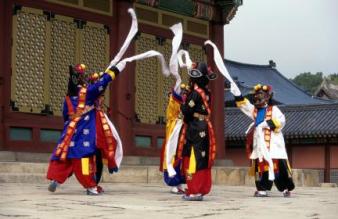EE00000163
 Cheoyongmu
Cheoyongmu
[Inscribed in 2009 (4.COM) on the Representative List of the Intangible Cultural Heritage of Humanity]
Cheoyongmu refers to a court dance performed by five dancers in five directions (west, east, north, south, and center). Hence it is also called Obang (quintet) Cheoyongmu. It is unique in that it is the only form of a court dance performed using human masks. Designated Important Intangible Cultural Heritage on January 8, 1971, Cheoyongmu is a grandiose, mystic dance performed by male dancers.
At the end of the Silla Kingdom (57 B.C. – A.D. 935), King Heongang went on an excursion to the seaport of Gaeunpo (present-day Sejuk Village area in Hwangseong-dong) in the southeastern city of Ulsan. On his way back home, the king felt strange about the sky covered with dark clouds and fog and asked his retainers the reason. “As it is caused by the dragon in the east sea, it should be resolved by conducting good deeds,” a court astronomer replied. Therefore, when the king had a temple built for the dragon, the dark clouds disappeared and the dragon, along with his seven sons, emerged from the east sea and danced. One of the dragon’s sons, named Cheoyong, followed King Heongang to the capital, married a beautiful woman and held an official rank. One night, when Cheoyong returned home, he found the spirit of smallpox trying to attack his wife. As Cheoyong sang and danced, the smallpox spirit presented itself and kneeled in apology. Since then, people have attached an image of Cheoyong to the gate to dispel evil spirits and invite auspicious energies.
Until the late Goryeo (918-1392) era, Cheoyongmu had been performed by a dancer, while by the reign of King Sejong (r. 1418-1450) of the Joseon Dynasty it was danced by five performers. According to the Akhak Gwebeom, or the Canon of Music, Cheoyongmu was performed twice at the narye ceremony, which was conducted on New Year’s Eve to ward off evil spirits and the god of death of the passing year.
The five dancers are clad in white, blue, black, red and yellow, symbolizing the west, east, north, south and center respectively. Based on the theories of Yin and Yang and the Five Elements, Cheoyongmu symbolizes the repelling of misfortune. The stately and vigorous movements reveal a valiant spirit and magnanimity.
Cheoyongmu begins with proceeding toward the king to the music of sujecheon (“Long Life as Eternal as the Heavens”), singing the first line of “Cheoyongga” (Song of Cheoyong) with the words “silla seongdae soseongdae” (“Silla, the period of brightness and greatness”) in the lyric song rhythm of eolnak. Then, the dancers bow to the king and move to the center of the stage to the music of hyangdang gyoju (ensemble by Korean and Tang instruments). To the slow tempo music of seryeongsan (“Mt. Seryeongsan”), they form a square to dance sanjak hwamu (“Scattering in the Form of a Flower”) and rotate to the right. As the formation is changed to a cross, the music is also changed to samhyeon dodeuri (slow 6/4 beat music by three strings). After the dances of suyang sumu (“Dangled and Raised Hands Dance”) and mureup dipimu (“Moving Knee to Change Direction”), the dancers change the formation into a circle and rotate to the left. As the formation is changed to a straight line again, they recite a verse from the Song of Cheoyong, saying “sanha cheolniguk” (“To mountains or fields that are far away”) in the lyric song rhythm of pyeonak and then leave the stage, dancing nakhwa yusu (“Falling Petals and Flowing Streams”) to the music of songgu yeojigok (a sort of dodeuri).
In light wine color, the Cheoyong mask features white teeth, tin earrings with a lead bead, and a black official hat decorated with two blossoms of peonies and seven peaches. The light wine color and peaches symbolize warding off the evil spirit, while peonies signify inviting auspicious energies.
Republic of Korea
2009


